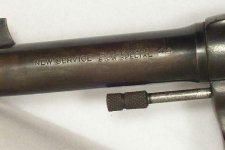jesseatamez
Member
Hey Everyone,
So back in the day, Colt really didn't like putting S&W's name on their products and vice versa. We see the lengths Colt went to to avoid just this by the flat nosed 38 Colt Special, 32Colt New Police, etc. Now, the exception it seems always lies in the large frame revolvers. We've seen pre-war factory N-Frame 45 Colt revolvers thusly rollmarked, rare yes, but they do exist. However, I found an interesting example online of the same practice from the boys over at Hartford that runs opposite of their other cartridge rebranding efforts. It's a New Service, and it's marked on the barrel as 44 Russian and S&W Special. Now if Colt insisted on tweaking the bullet designs for the smaller calibres just to avoid S&W's name being on their barrels, then why would they not do the same with the 44 Special? In simpler terms, why no flat nosed "44 Colt Special?"
I personally think it could be one of three things or some combination thereof:
Maybe each company's respective big bore offering was off limits for rebranding due to a "gentleman's agreement" between the manufacturers or just out of respect.
Or, it could be a volume driven issue, the medium and small frame guns were sold in far greater quantities than the large frame revolvers from each respective manufacturer. So, putting the competition's name on the barrels of many thousands of guns was unappealing on a different level. Heck, even S&W who lead modern revolver cartridge development beginning with it's introduction of the 32 S&W Long, put US Service Ctg on the early 38 Long Colt K Frames.
Or maybe it was an issue of chambering popularity, from what I've read the available chamberings for the New Service were quite diverse, moreso than the N-Frame Smiths. I know 45 Colt was the most popular commercial chambering for the New Service. Colt, thinking the demand for a 44 Special version would be low, probably took little issue with rollmarking S&W into those barrels.
I'm curious to hear everyone else's thoughts, thanks in advance.
So back in the day, Colt really didn't like putting S&W's name on their products and vice versa. We see the lengths Colt went to to avoid just this by the flat nosed 38 Colt Special, 32Colt New Police, etc. Now, the exception it seems always lies in the large frame revolvers. We've seen pre-war factory N-Frame 45 Colt revolvers thusly rollmarked, rare yes, but they do exist. However, I found an interesting example online of the same practice from the boys over at Hartford that runs opposite of their other cartridge rebranding efforts. It's a New Service, and it's marked on the barrel as 44 Russian and S&W Special. Now if Colt insisted on tweaking the bullet designs for the smaller calibres just to avoid S&W's name being on their barrels, then why would they not do the same with the 44 Special? In simpler terms, why no flat nosed "44 Colt Special?"
I personally think it could be one of three things or some combination thereof:
Maybe each company's respective big bore offering was off limits for rebranding due to a "gentleman's agreement" between the manufacturers or just out of respect.
Or, it could be a volume driven issue, the medium and small frame guns were sold in far greater quantities than the large frame revolvers from each respective manufacturer. So, putting the competition's name on the barrels of many thousands of guns was unappealing on a different level. Heck, even S&W who lead modern revolver cartridge development beginning with it's introduction of the 32 S&W Long, put US Service Ctg on the early 38 Long Colt K Frames.
Or maybe it was an issue of chambering popularity, from what I've read the available chamberings for the New Service were quite diverse, moreso than the N-Frame Smiths. I know 45 Colt was the most popular commercial chambering for the New Service. Colt, thinking the demand for a 44 Special version would be low, probably took little issue with rollmarking S&W into those barrels.
I'm curious to hear everyone else's thoughts, thanks in advance.
Attachments
Last edited:



